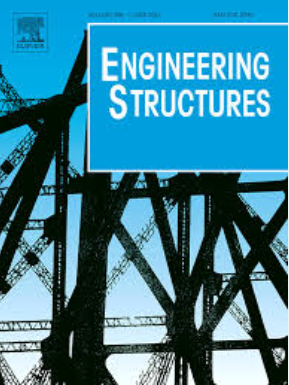新型橡胶夹层w梁护栏系统在车辆碰撞下的道路安全性能:实验与数值研究
IF 6.4
1区 工程技术
Q1 ENGINEERING, CIVIL
引用次数: 0
摘要
w梁护栏作为路边安全屏障被广泛采用,以吸收冲击能量,最大限度地降低乘员风险,并使车辆重新回到道路上,提高公路交通安全。为了提高安全性能,本研究提出了一种新型的装有橡胶夹层的w梁护栏。通过试验和有限元分析对这种新型护栏的抗冲击性能进行了评价。在不同的冲击能量、不同的橡胶厚度和不同的锤头形状下,采用落锤冲击装置对6根带有橡胶夹层层的w梁护栏进行了试验。得到了护栏的动力响应,包括冲击力、跨中挠度和破坏模式。在落锤冲击下,护栏主要表现为整体变形和局部凹痕。橡胶层在吸收能量方面起着重要的作用。建立了新型护栏的有限元模型,并与试验结果进行了对比验证。利用验证过的模型,建立了48 m长的护栏系统和车辆模型,分析了新型w梁护栏系统在车辆碰撞下的性能。数值计算结果表明,夹层橡胶护栏系统可以有效地减小车辆的最大侧向位移,并有助于改变车辆的轨迹。乘员冲击速度(OIV)和乘员骑下加速度(ORA)均符合JTG B05-01标准。在此基础上,综合考虑车辆速度、w梁钢轨板厚度、橡胶层厚度等参数,对新型护栏的重定向能力和乘员安全进行了评价,确定了在研究参数范围内的理想护栏配置。本文章由计算机程序翻译,如有差异,请以英文原文为准。
Road safety performance of a new W-beam guardrail system with rubber sandwich layer under vehicle collisions: Experimental and numerical studies
The W-beam guardrail is widely employed as a roadside safety barrier to absorb impact energy, minimize occupant risk and redirect vehicles back onto the road, enhancing highway traffic safety. This study introduces an innovative W-beam guardrail equipped with a rubber sandwich layer aimed at improving safety performance. The impact resistance of this new guardrail was evaluated through both experiments and finite element (FE) analysis. Six W-beam guardrails with a rubber sandwich layer were manufactured and tested using a drop-hammer impact device under different impact energies, rubber thicknesses and hammer shapes. The dynamic responses of the guardrail, including impact force, mid-span deflection and failure mode, were obtained. Under drop-hammer impact, the guardrail primarily exhibited global deformation along with localized denting at the point of impact. The rubber layer plays an important role in energy absorption. Additionally, FE models of the new guardrail were established and validated against experimental results. Using the validated model, a 48-meter-long guardrail system and vehicle model were established to analyze the performance of the new W-beam guardrail system under vehicle collision. The numerical results indicate that the guardrail system with a rubber sandwich layer effectively reduces the maximum lateral displacement and helps redirect the vehicle's trajectory. Both the occupant impact velocity (OIV) and occupant ridedown acceleration (ORA) comply with the JTG B05–01 standard. Furthermore, the redirecting capacity of the new guardrail and occupant safety were evaluated, considering various parameters such as vehicle velocity, W-beam rail plate thickness, and rubber layer thickness, to determine the promising guardrail configuration within the studied parameter range.
求助全文
通过发布文献求助,成功后即可免费获取论文全文。
去求助
来源期刊

Engineering Structures
工程技术-工程:土木
CiteScore
10.20
自引率
14.50%
发文量
1385
审稿时长
67 days
期刊介绍:
Engineering Structures provides a forum for a broad blend of scientific and technical papers to reflect the evolving needs of the structural engineering and structural mechanics communities. Particularly welcome are contributions dealing with applications of structural engineering and mechanics principles in all areas of technology. The journal aspires to a broad and integrated coverage of the effects of dynamic loadings and of the modelling techniques whereby the structural response to these loadings may be computed.
The scope of Engineering Structures encompasses, but is not restricted to, the following areas: infrastructure engineering; earthquake engineering; structure-fluid-soil interaction; wind engineering; fire engineering; blast engineering; structural reliability/stability; life assessment/integrity; structural health monitoring; multi-hazard engineering; structural dynamics; optimization; expert systems; experimental modelling; performance-based design; multiscale analysis; value engineering.
Topics of interest include: tall buildings; innovative structures; environmentally responsive structures; bridges; stadiums; commercial and public buildings; transmission towers; television and telecommunication masts; foldable structures; cooling towers; plates and shells; suspension structures; protective structures; smart structures; nuclear reactors; dams; pressure vessels; pipelines; tunnels.
Engineering Structures also publishes review articles, short communications and discussions, book reviews, and a diary on international events related to any aspect of structural engineering.
 求助内容:
求助内容: 应助结果提醒方式:
应助结果提醒方式:


